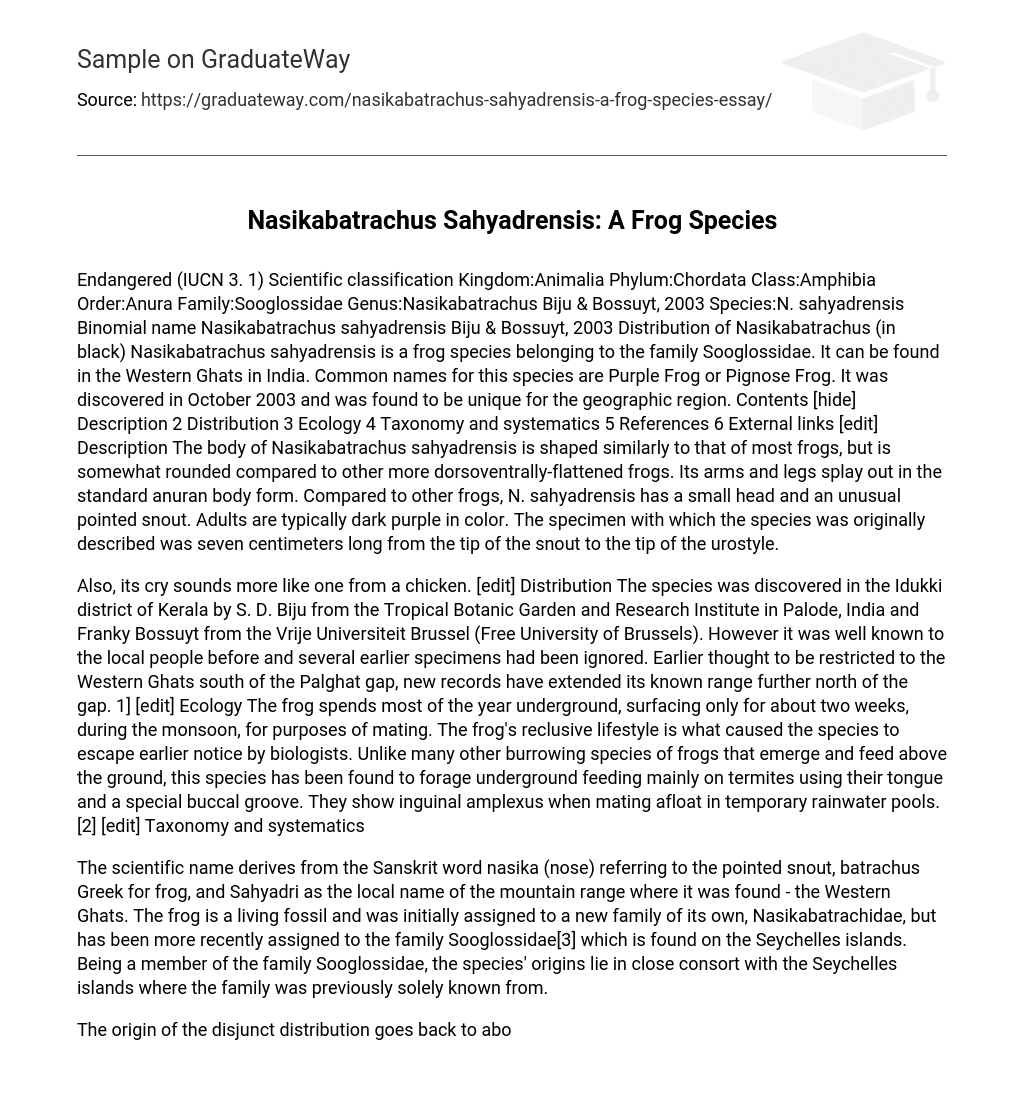Endangered (IUCN 3. 1) Scientific classification Kingdom:Animalia Phylum:Chordata Class:Amphibia Order:Anura Family:Sooglossidae Genus:Nasikabatrachus Biju & Bossuyt, 2003 Species:N. sahyadrensis Binomial name Nasikabatrachus sahyadrensis Biju & Bossuyt, 2003 Distribution of Nasikabatrachus (in black) Nasikabatrachus sahyadrensis is a frog species belonging to the family Sooglossidae. It can be found in the Western Ghats in India. Common names for this species are Purple Frog or Pignose Frog. It was discovered in October 2003 and was found to be unique for the geographic region. Contents [hide] Description 2 Distribution 3 Ecology 4 Taxonomy and systematics 5 References 6 External links [edit] Description The body of Nasikabatrachus sahyadrensis is shaped similarly to that of most frogs, but is somewhat rounded compared to other more dorsoventrally-flattened frogs. Its arms and legs splay out in the standard anuran body form. Compared to other frogs, N. sahyadrensis has a small head and an unusual pointed snout. Adults are typically dark purple in color. The specimen with which the species was originally described was seven centimeters long from the tip of the snout to the tip of the urostyle.
Also, its cry sounds more like one from a chicken. [edit] Distribution The species was discovered in the Idukki district of Kerala by S. D. Biju from the Tropical Botanic Garden and Research Institute in Palode, India and Franky Bossuyt from the Vrije Universiteit Brussel (Free University of Brussels). However it was well known to the local people before and several earlier specimens had been ignored. Earlier thought to be restricted to the Western Ghats south of the Palghat gap, new records have extended its known range further north of the gap. 1] [edit] Ecology The frog spends most of the year underground, surfacing only for about two weeks, during the monsoon, for purposes of mating. The frog’s reclusive lifestyle is what caused the species to escape earlier notice by biologists. Unlike many other burrowing species of frogs that emerge and feed above the ground, this species has been found to forage underground feeding mainly on termites using their tongue and a special buccal groove. They show inguinal amplexus when mating afloat in temporary rainwater pools. [2] [edit] Taxonomy and systematics
The scientific name derives from the Sanskrit word nasika (nose) referring to the pointed snout, batrachus Greek for frog, and Sahyadri as the local name of the mountain range where it was found – the Western Ghats. The frog is a living fossil and was initially assigned to a new family of its own, Nasikabatrachidae, but has been more recently assigned to the family Sooglossidae[3] which is found on the Seychelles islands. Being a member of the family Sooglossidae, the species’ origins lie in close consort with the Seychelles islands where the family was previously solely known from.
The origin of the disjunct distribution goes back to about 100 million years ago, during which time India, the Seychelles and Madagascar formed a single landmass which split due to continental drift. [edit] References ^ Das, K. S. Anoop 2006 Record of Nasikabatrachus from the Northern Western Ghats. Zoos’ Print Journal 21(9):2410 PDF ^ C. Radhakrishnan, K. C. Gopi and Muhamed Jafer Palot (2007) Extension of range of distribution of Nasikabatrachus sahyadrensis Biju & Bossuyt (Amphibia: Anura: Nasikabatrachidae) along Western Ghats, with some insights into its bionomics.
Current Science, 92(2):213-216 PDF ^ Frost, Darrel R. 2006. Amphibian Species of the World: an online reference. Version 4. 0 (17 August 2006). Electronic Database accessible at http://research. amnh. org/herpetology/amphibia/index. php. American Museum of Natural History, New York, USA. 4. C. Radhakrishnan, K. C. Gopi and K. P. Dinesh. 2007. Zoogeography of Nasikabatrachus sahyadrensis Biju and Bossuyt (Amphibia: Anura; Nasikabatrachidae) in the Western Ghats, India. Records of the Zoological Survey of India. 107(Part 4): 115-121. (pdf available on request) edit] External links Continental drift and the Sooglossidae National Geographic Nature 425, 711 – 714 (16 October 2003) – Abstract BBC News article Pictures “Purple frog delights scientists” (in English). BBC News (BBC). 2003-10-17. http://news. bbc. co. uk/2/hi/science/nature/3200214. stm. Retrieved 2007-08-13. [hide]v • d • eExtant anuran families by suborder Kingdom Animalia · Phylum Chordata · Subphylum Craniata · Superclass Tetrapoda · Class Amphibia ArchaeobatrachiaAscaphidae · Bombinatoridae · Discoglossidae · Leiopelmatidae
MesobatrachiaMegophryidae · Pelobatidae · Pelodytidae · Pipidae · Scaphiopodidae · Rhinophrynidae NeobatrachiaAmphignathodontidae · Aromobatidae · Arthroleptidae · Brachycephalidae · Bufonidae · Centrolenidae · Craugastoridae · Dendrobatidae · Heleophrynidae · Hemisotidae · Hylidae · Hyperoliidae · Leptodactylidae · Mantellidae · Microhylidae · Myobatrachidae · Petropedetidae · Ranidae · Rhacophoridae · Rhinodermatidae · Sooglossidae Retrieved from “http://en. wikipedia. org/wiki/Purple_frog”
Categories: IUCN Red List endangered species | Frogs by classification | Frogs of India | Amphibians of Asia | Animals described in 2003 | Monotypic amphibian genera Hidden categories: Articles with ‘species’ microformats Personal tools New features Log in / create account Namespaces Article Discussion VariantsViews Read Edit View history ActionsSearch SearchNavigation Main page Contents Featured content Current events Random article Interaction About Wikipedia Community portal Recent changes Contact Wikipedia Donate to Wikipedia Help Toolbox What links here Related changes
Upload file Special pages Permanent link Cite this page Print/export Create a book Download as PDF Printable version Languages Cesky Deutsch Dine bizaad Espanol Francais Magyar ?????? Nederlands Polski Portugues ??????? ????? ?????????? This page was last modified on 7 July 2010 at 08:42. Text is available under the Creative Commons Attribution-ShareAlike License; additional terms may apply. See Terms of Use for details. Wikipedia® is a registered trademark of the Wikimedia Foundation, Inc. , a non-profit organization. Contact us Privacy policy About Wikipedia Disclaimers





